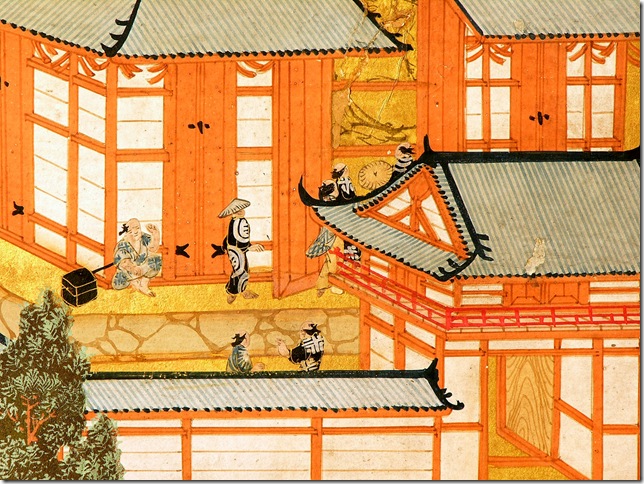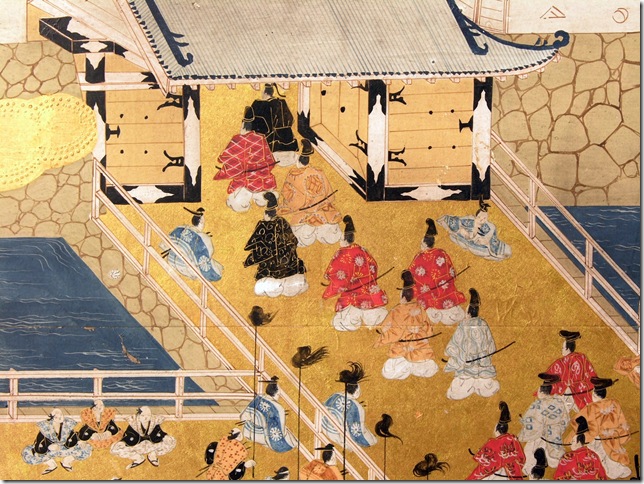With its simple harmony and elegant lines, much classic Asian art has been easy to digest but not to remember. This is its — or rather, our — struggle.
And so it is with the Morikami Museum and Japanese Gardens’ current exhibit, Kyoto: A Place in Art. As soon as we leave the exhibit, we’re in fear of forgetting what we’ve seen.
It doesn’t help that Kyoto: A Place in Art is not very exciting, at least not in the way that would require cool 3-D glasses. What is required of you is to empty your mind so it doesn’t interfere, for there is no way a show this quiet has a chance of being absorbed unless we forget for a minute — more like an hour — our busy modern lives.
The exhibit, which runs through Oct. 17, opens with a series of eight photographs by Haruzo Ohashi from the Morikami’s permanent collection. All of them feature sharp, beautiful images of temples, gardens and pavilions of relevant importance to a city that served as Japan’s capital from 794 to 1868. Still, the images are far from unique.
Nature happens to be pretty extraordinary in these sites, so it is no surprise the photos take our breath away, particularly that of Kinkaku-Ji (Temple of the Golden Pavilion). This three-tiered Zen temple served as the retreat of retired shogun Yoshimitsu. Here it appears with its top floors completely covered in gold leaf and overlooking the famous pond, which functions more like a mirror. The building has had its share of tragedies having been burned down several times, the last time in 1950.
When not fusing with the outside world, the structures appear to have completely disappeared, as in Ohashi’s Shugaku-in (Imperial Villa: Winter), where a white and grayish veil of snow has taken over the print and left no chance for inner cheering. Thankfully, the autumn and the sunset photographs that accompany the winter piece lighten up our spirit with unbelievable intense colors. The sunset piece gets my attention with the curious line of trees that look as if strategically placed next to one another.
Notably missing from this trio is a spring season photograph, which one can only imagine would be impregnated with cherry blossoms. There are no humans depicted in any of the photos, leading us to wonder whether humanity and these glorious places can really coexist.
The presence of swords, spears and folding screens is not enough to get a mood going. I can’t help thinking that having Japanese melodies or Zen music playing in the background would have helped. Unlike tea ceremony and koi feeding, which set a particular mood, the show doesn’t seem to transmit much. This is perhaps intentional, as to leave room for inward reflection.
If that’s the case, the best place to cleanse the mind is by the woodblock paintings depicting rock gardens: Sekitei and Ryoan-ji. Each of the seven works, ranging in date from 1960 to 2001 and by seven different artists, gives us a personal interpretation of these famous dry landscapes, also known as Zen gardens.
Painters such as Toshi Yoshida, son of the great Hiroshi Yoshida, were considered sosaku hanga artists, meaning they engaged in every aspect of the woodblock painting creative process: designing, carving, printing and publishing. His Sekitei, dated 1963, is the warmest depiction of the garden in the show.
Following it is an unexpected geometric composition titled Ryoan-ji, Kyoto by Kiyoshi Saito. It’s rather Pollockian compared to the rest in the sense that the work is more concerned with free expression and experimentation than with retention of form. For instance, although Saito’s figures are still clearly defined, he has placed circles instead of realistic-looking rocks and given each a different texture. Next to the other pieces here, which are more tri-dimensional and play with angles and shadows, Saito’s primitive take on the rock garden seems very flat but yet fresh and unique.
A scroll right before the woodblock pieces titled Fishing in Autumn is the piece I like the most. Hine Taizan gives us the scholar turning to seclusion and isolation to reconnect with his inner self. Here he appears inside a boat but is not in a rush. The piece isn’t about anxiety or urgency, but rather a man making a quiet exit out of the social and political life.
When we reach the pair of six-panel folding screens we sort of sense the presence of something important, even when we cannot fully understand it. Think of them as visual narratives, starting from right to left. The screens, dating from the Edo period, 17th or 18th century, are meant to portray the life of the various social classes in Kyoto. Too bad that the glass wall protecting them prevents us from taking a closer look at the tiny figures. Don’t be shy about using the description to identify the important sites on the panels.
You will find the striking dance platform of the Kiyomizu-dara temple (top of the fifth panel on right screen) and, right below it, the Great Buddha Hall distinguished by a bright orange hue and a green roof. The overall view reveals black outlines dancing, meditating, fishing and carrying baskets. Bridges of different sizes connect the top section with the middle and the bottom sections of the panels while members of the imperial court make their way to Nijo Castle.
On your way out, before the countdown toward forgetfulness begins and while your mind is still fresh with images, find comfort in the fact that perhaps it isn’t meant for you to remember this show after all. You don’t need to retain all the details, nor are you expected to give your friends a lecture on what you learned during this visit.
After all, in Zen, learning and knowledge should be open and free from practical use as skills; knowledge for its own sake is sufficient. In other words, enjoy, and don’t worry about giving your visit a later purpose.
Kyoto: A Place in Art is showing at the Morikami Museum through Oct. 17 along with Kaiju! Monster Invasion!, an exhibit of toys based on Japanese monster movies. For more information, call 561-495-0233 or visit www.morikami.org.

